Ice Tea Market
Ice Tea Market Size and Share Forecast Outlook 2025 to 2035
Ice tea market is projected to grow from USD 25.0 billion in 2025 to USD 39.5 billion by 2035, at a CAGR of 4.7%. Ready-to-drink will dominate with a 78.0% market share, while reduced/no sugar will lead the sweetener segment with a 52.0% share.
Ice Tea Market Forecast and Outlook (2025 to 2035
The global ice tea market is valued at USD 25.0 billion in 2025. It is slated to reach USD 39.5 billion by 2035, recording an absolute increase of USD 14.5 billion over the forecast period. This translates into a total growth of 58.0%, with the market forecast to expand at a CAGR of 4.7% between 2025 and 2035.
The market is expected to grow by nearly 1.58X during the same period, supported by increasing health consciousness and natural beverage preferences, growing demand for refreshing and convenient drinks, expanding flavor innovations and premium offerings, and rising availability through diverse retail channels.
Quick Stats for Ice Tea Market
- Ice Tea Market Value (2025): USD 25.0 billion
- Ice Tea Market Forecast Value (2035): USD 39.5 billion
- Ice Tea Market Forecast CAGR: 4.7%
- Leading Type in Ice Tea Market: Ready-to-drink
- Key Growth Regions in Ice Tea Market: North America, Asia-Pacific, and Europe
- Key Players in Ice Tea Market: Coca-Cola, PepsiCo Lipton, Nestlé, Arizona Beverage, Ito En, Keurig Dr Pepper
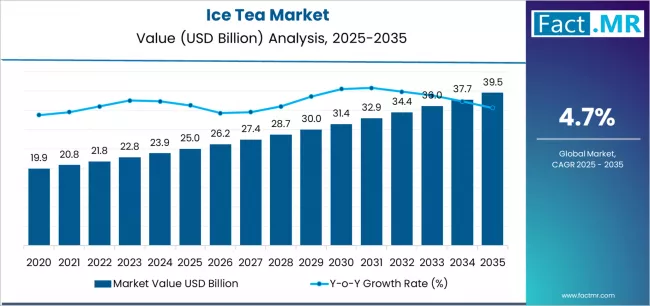
The rising health awareness among consumers is a key driver for the ice tea market, as individuals increasingly seek beverages with lower sugar content, natural ingredients, and functional benefits such as antioxidants and vitamins. Green tea-based iced drinks, herbal infusions, and blends with natural fruit extracts are witnessing heightened consumer adoption due to their perceived wellness benefits. Market players are responding with fortified and reduced-sugar options, positioning ice tea as not only a refreshing beverage but also a health-conscious choice for everyday consumption.
Flavor innovation remains a pivotal growth factor in the market, with brands experimenting with exotic fruit combinations, botanical infusions, and limited-edition seasonal flavors. This strategy not only attracts younger consumers who are open to trying novel tastes but also fosters premiumization within the segment. Consumers are increasingly willing to pay a higher price for artisanal, organic, or naturally flavored ice teas, driving the expansion of premium product portfolios.
The convenience factor further propels market growth, as ready-to-drink (RTD) ice teas cater to busy lifestyles, particularly in urban areas. Single-serve bottles, multi-pack offerings, and on-the-go packaging formats enhance accessibility, making ice tea a preferred beverage for work, travel, and outdoor activities. Supermarkets, convenience stores, e-commerce platforms, and foodservice outlets are increasingly providing a variety of ice tea options, ensuring wide availability across traditional and modern retail channels.
Geographical expansion also plays a significant role in market development. North America and Europe remain mature markets with steady demand for premium and functional variants, while Asia Pacific demonstrates rapid growth due to rising disposable incomes, urbanization, and changing consumption habits. Countries such as China, Japan, and India are witnessing strong uptake of RTD iced beverages and health-oriented flavors, further bolstering market potential.
Strategic initiatives by key market players, including product launches, collaborations, and mergers & acquisitions, are enhancing market competitiveness and driving innovation. Sustainability trends, such as eco-friendly packaging and ethically sourced ingredients, are increasingly influencing purchasing decisions, adding another dimension to market growth.
Between 2025 and 2030, the ice tea market is projected to expand from USD 25.0 billion to USD 31.5 billion, resulting in a value increase of USD 6.5 billion, which represents 44.8% of the total forecast growth for the decade.
This phase of development will be shaped by increasing health-conscious beverage consumption, growing premium and organic tea trends, and expanding functional ingredient integration. Beverage manufacturers and tea companies are expanding their ice tea capabilities to address the growing demand for refreshing and health-oriented beverage alternatives.
Ice Tea Market Key Takeaways
| Metric | Value |
|---|---|
| Estimated Value in (2025E) | USD 25.0 billion |
| Forecast Value in (2035F) | USD 39.5 billion |
| Forecast CAGR (2025 to 2035) | 4.7% |
From 2030 to 2035, the market is forecast to grow from USD 31.5 billion to USD 39.5 billion, adding another USD 8.0 billion, which constitutes 55.2% of the overall ten-year expansion. This period is expected to be characterized by the expansion of reduced-sugar and no-sugar formulations, development of functional tea beverages, and growth of premium artisanal tea offerings. The growing adoption of healthy lifestyle choices and natural ingredient preferences will drive demand for ice tea with enhanced health benefits and authentic flavor profiles.
Between 2020 and 2025, the ice tea market experienced steady growth, driven by increasing consumer preference for healthier beverage alternatives and growing recognition of ice tea as a refreshing and convenient option that combines taste satisfaction with perceived health benefits. The market developed as beverage companies and consumers recognized the potential for ice tea to provide natural hydration, antioxidant benefits, and diverse flavor experiences while meeting modern lifestyle requirements for convenient and portable refreshment.
Why is the Ice Tea Market Growing?
Market expansion is being supported by the increasing consumer shift toward healthier beverage alternatives driven by wellness consciousness and sugar reduction trends, alongside the corresponding need for refreshing and natural drinks that can provide hydration benefits, antioxidant properties, and diverse flavor experiences across various consumption occasions and demographic segments.
Modern beverage manufacturers and tea companies are increasingly focused on implementing ice tea solutions that can meet health requirements, support lifestyle preferences, and provide convenient refreshment while maintaining taste appeal and market competitiveness. The growing emphasis on natural ingredients and functional beverages is driving demand for ice tea that can support wellness objectives, provide antioxidant benefits, and ensure comprehensive health advantages through tea-based formulations with reduced artificial additives.
Beverage manufacturers' preference for products that combine health positioning with consumer appeal and market differentiation is creating opportunities for innovative ice tea implementations. The rising influence of convenience culture and on-the-go consumption is also contributing to increased adoption of ice tea that can provide superior refreshment without compromising health consciousness or taste satisfaction.
Segmental Analysis
The market is segmented by type, sweetener, and distribution channel. By type, the market is divided into ready-to-drink and powder/instant. Based on sweetener, the market is categorized into reduced/no sugar and standard sugar. By distribution channel, the market is segmented into retail, foodservice, and online.
By Type, the Ready-to-Drink Segment Leads the Market
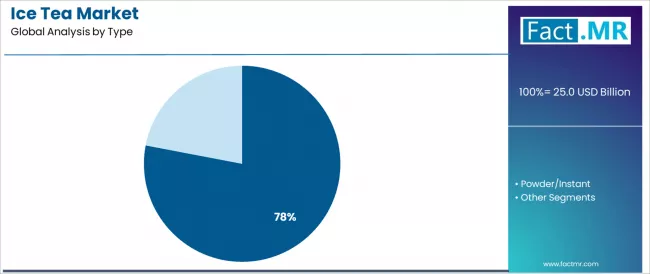
The ready-to-drink (RTD) segment is expected to retain its dominant position in the global ice tea market in 2025, capturing approximately 78.0% of total market share. RTD ice teas continue to appeal to consumers due to their convenience, portability, and consistent taste profiles, making them a preferred choice for on-the-go consumption, office breaks, and outdoor activities. Busy lifestyles and urban consumption patterns have strengthened demand for RTD formats, positioning them as a cornerstone of modern beverage consumption.
Beverage manufacturers are increasingly investing in advanced bottling and packaging technologies to enhance freshness, shelf life, and flavor stability, ensuring RTD ice teas meet consumer expectations for instant refreshment and quality. The segment also benefits from extensive distribution through supermarkets, convenience stores, e-commerce platforms, and foodservice outlets, maximizing accessibility across diverse retail channels.
With its ability to align with lifestyle needs, consumption convenience, and flavor consistency, the RTD format remains central to strategic growth initiatives within the ice tea market, forming the foundation for innovation in ready-to-consume beverages.
By Sweetener, the Reduced/No Sugar Segment Dominates Market Demand
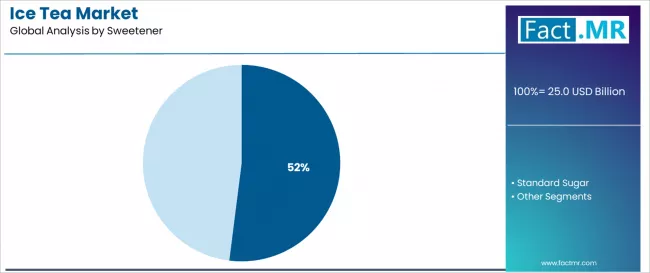
The reduced/no sugar segment is projected to account for the largest share of ice tea consumption in 2025, representing around 52.0% of the market. Growing health awareness and dietary consciousness are driving consumers toward lower-calorie beverages and reduced/no sugar ice teas meet the demand for guilt-free refreshment without compromising taste. These formulations are increasingly viewed as essential for consumers seeking healthier beverage alternatives that support wellness goals, weight management, and overall lifestyle optimization.
Innovation in natural sweeteners, such as stevia, monk fruit, and erythritol, has expanded product options, enabling manufacturers to offer ice teas with reduced sugar content while maintaining a pleasant taste profile. Beverage companies are also incorporating functional ingredients, such as antioxidants and herbal extracts, into low-sugar variants, enhancing their appeal to health-focused consumer segments.
The reduced/no sugar segment’s prominence reflects a broader market shift toward beverages that combine indulgence with nutritional awareness, and it is expected to continue driving product development and market growth as consumer preference for healthier alternatives strengthens.
What are the Drivers, Restraints, and Key Trends of the Ice Tea Market?
The ice tea market is advancing steadily due to increasing consumer preference for healthier beverage alternatives driven by wellness consciousness and sugar reduction trends, alongside growing demand for natural and refreshing drinks that provide convenience, taste satisfaction, and perceived health benefits while addressing diverse flavor preferences and consumption occasions across various demographic segments.
However, the market faces challenges, including intense competition from other healthy beverage categories, seasonal consumption variations affecting demand stability, and regulatory pressures regarding sugar content and health claims. Innovation in functional ingredient integration and premium flavor development continues to influence product differentiation and market expansion patterns.
Expansion of Health-Conscious and Functional Beverage Trends
The growing health consciousness is driving demand for ice tea that can provide functional benefits, antioxidant properties, and wellness support through natural tea compounds, added vitamins, and specialized functional ingredients that appeal to health-focused consumers. Wellness-oriented consumers require advanced ice tea formulations that deliver superior health benefits across multiple wellness parameters while maintaining refreshment satisfaction and convenient consumption.
Beverage companies are increasingly recognizing the competitive advantages of functional ice tea positioning for health markets and wellness-conscious consumer segments, creating opportunities for specialized products designed for health optimization and functional beverage applications.
Integration of Premium and Artisanal Tea Experiences
Modern ice tea manufacturers are incorporating premium tea sourcing and artisanal brewing methods to enhance product quality, support premium positioning, and appeal to sophisticated consumers seeking authentic and high-quality tea experiences through craft brewing, specialty tea varieties, and premium ingredient integration.
Leading companies are developing single-origin tea products, implementing cold-brew technologies, and advancing brewing methods that optimize flavor profiles while maintaining convenience and accessibility.
These premium approaches improve product differentiation while enabling new market opportunities, including specialty retailers, premium foodservice, and discerning consumer segments seeking elevated beverage experiences.
Development of Sustainable and Natural Ingredient Positioning
The expansion of sustainability consciousness and natural ingredient preferences is driving demand for ice tea products with organic certification, sustainable sourcing practices, and clean label formulations that address environmental concerns and ingredient transparency requirements.
These sustainable applications require responsible sourcing capabilities and environmental stewardship systems that exceed traditional beverage production requirements, creating differentiated market segments with enhanced sustainability credentials.
Manufacturers are investing in sustainable supply chain development and organic ingredient sourcing to serve environmentally conscious applications while supporting innovation in responsible beverage production and sustainable consumption patterns.
Analysis of the Ice Tea Market by Key Countries
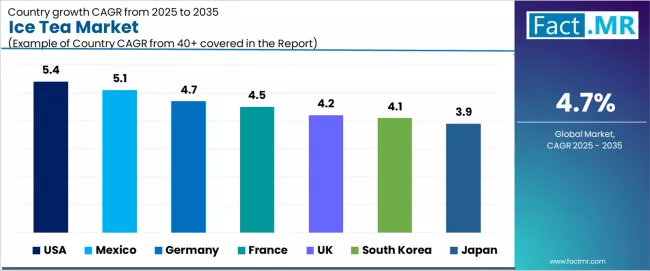
| Country | CAGR (2025-2035) |
|---|---|
| USA | 5.4% |
| Mexico | 5.1% |
| Germany | 4.7% |
| France | 4.5% |
| UK | 4.2% |
| South Korea | 4.1% |
| Japan | 3.9% |
The global ice tea market is witnessing strong growth across key regions, driven by evolving consumer preferences, health awareness, and expanding distribution networks. The United States leads with a projected CAGR of 5.4% through 2035, underpinned by a mature ready-to-drink (RTD) beverage culture, widespread health-conscious consumption, and a robust retail ecosystem that ensures widespread availability and adoption of ice tea products.
Mexico follows closely with a 5.1% CAGR, supported by rising beverage consumption, rapid urbanization, and expanding retail infrastructure that enhances accessibility to convenient and refreshing beverages. German consumers are increasingly favoring natural, organic, and high-quality products, contributing to a growth rate of 4.7% and highlighting the market’s emphasis on health-focused and premium consumption trends.
France is expected to record a CAGR of 4.5%, driven by a strong premium beverage culture, growing health awareness, and a rising appreciation for diverse tea varieties. The United Kingdom exhibits moderate growth at 4.2%, fueled by demand for convenient, health-conscious beverages and an increasing preference for premium tea options among urban consumers.
South Korea demonstrates a 4.1% growth rate, reflecting the rising popularity of wellness-focused beverages and a strong culture of premium tea consumption. Japan, with a well-established tea tradition and a focus on high-quality beverage experiences, is projected to grow at 3.9%, driven by consumer preference for natural flavors, functional ingredients, and trusted brands.
USA Leads Global Market Growth with Beverage Culture Leadership
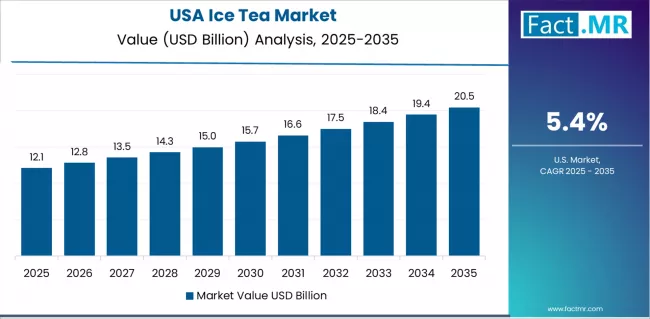
The ice tea market in the USA is projected to exhibit strong growth with a CAGR of 5.4% through 2035, driven by extensive ready-to-drink beverage culture and rapidly growing health-conscious consumption trends supporting ice tea adoption among diverse consumer demographics and lifestyle segments.
The country's established beverage market infrastructure and increasing consumer interest in healthier drink alternatives are creating substantial demand for ice tea solutions. Major beverage companies and tea manufacturers are establishing comprehensive product development capabilities to serve both domestic markets and export opportunities.
- Strong ready-to-drink culture and health-conscious trends are driving demand for ice tea throughout supermarkets, convenience stores, and foodservice establishments across urban markets, suburban communities, and diverse consumer segments seeking convenient refreshment options.
- Growing wellness consciousness and natural beverage preferences are supporting the rapid development of innovative ice tea formulations among companies seeking health positioning advantages and competitive differentiation in the expanding healthy beverage market.
Mexico Demonstrates Strong Market Potential with Beverage Consumption Growth
The ice tea market in Mexico is expanding at a CAGR of 5.1%, supported by the country's growing beverage consumption, expanding retail infrastructure, and increasing consumer preference for refreshing and convenient drinks suitable for warm climate conditions.
The country's beverage market development and retail expansion are driving demand for accessible ice tea products throughout urban and rural markets. Leading beverage companies and distributors are establishing comprehensive distribution networks to address growing demand for refreshing beverage alternatives.
- Rising beverage consumption and expanding retail availability are creating opportunities for ice tea adoption across supermarkets, convenience stores, and street vendors in major urban centers and developing retail markets.
- Growing health awareness and refreshment preferences are driving adoption of ice tea products among consumers seeking convenient and satisfying drink alternatives for active lifestyles and warm weather consumption.
Germany Demonstrates Quality Excellence with Natural Focus
The ice tea market in Germany is expanding at a CAGR of 4.7%, driven by the country's emphasis on natural and organic beverage preferences, health consciousness, and comprehensive approach to quality-focused consumption supporting premium ice tea development.
Germany's quality standards and natural ingredient focus are driving demand for superior ice tea solutions. Leading beverage companies and organic manufacturers are establishing comprehensive quality programs for natural beverage development.
- Advanced natural beverage standards and consumer preference for organic products are creating demand for premium ice tea products among health-conscious consumers seeking quality ingredients and sustainable production methods.
- Strong health consciousness and quality focus are supporting the adoption of certified organic and natural ice tea formulations across health stores, organic retailers, and premium grocery channels throughout major urban markets.
France Focuses on Premium Beverages and Tea Culture
The ice tea market in France is expanding at a CAGR of 4.5%, driven by the country's premium beverage culture, health awareness, and comprehensive approach to sophisticated drink experiences supporting ice tea integration into French beverage consumption patterns.
France's beverage sophistication and quality appreciation are supporting investment in premium ice tea technologies. Major beverage companies and tea specialists are establishing comprehensive innovation programs incorporating ice tea with French beverage expertise.
- Advanced beverage culture and consumer preference for premium drink experiences are creating demand for high-quality ice tea throughout specialty retailers, cafes, and premium grocery outlets serving sophisticated consumer segments.
- Strong tea appreciation and premium positioning preferences are driving the adoption of artisanal ice tea applications meeting high quality standards and sophisticated taste preferences across diverse beverage applications.
UK Shows Market Leadership with Health-Conscious Integration
The ice tea market in the UK is expanding at a CAGR of 4.2%, supported by the country's health-conscious beverage choices, convenience consumption preferences, and growing tea culture appreciation supporting ice tea adoption across mainstream and premium market segments.
The UK's tea heritage and health trends are driving demand for innovative ice tea solutions. Leading beverage companies and tea brands are investing in product innovation and market expansion for healthy beverage alternatives.
- Advanced health consciousness and consumer interest in convenient wellness beverages are creating opportunities for ice tea products throughout supermarkets, health stores, and convenience retailers serving health-focused consumer segments.
- Strong tea culture and convenience trends are driving the adoption of ice tea formulations across mainstream retail channels, foodservice establishments, and specialty outlets targeting tea enthusiasts and health-conscious consumers.
South Korea Demonstrates Wellness Leadership with Premium Tea Culture
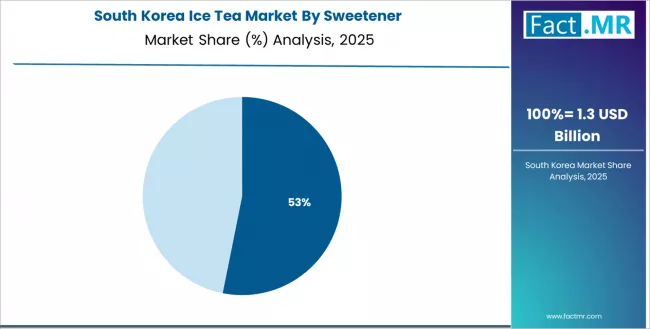
The ice tea market in South Korea is expanding at a CAGR of 4.1%, supported by the country's wellness beverage culture, premium tea appreciation, and strong emphasis on health optimization and functional drinks supporting sophisticated ice tea utilization.
The nation's wellness consciousness and premium beverage trends are driving demand for advanced ice tea solutions. Leading beverage companies are investing extensively in premium product development and wellness market expansion.
- Advanced wellness culture and premium beverage demand are creating demand for ice tea products throughout convenience stores, cafes, and premium retailers serving health-conscious and quality-focused consumer segments.
- Strong tea culture and functional beverage trends are supporting the adoption of ice tea formulations designed for health benefits, premium positioning, and wellness optimization across diverse consumer demographics.
Japan Shows Premium Focus with Tea Culture Excellence
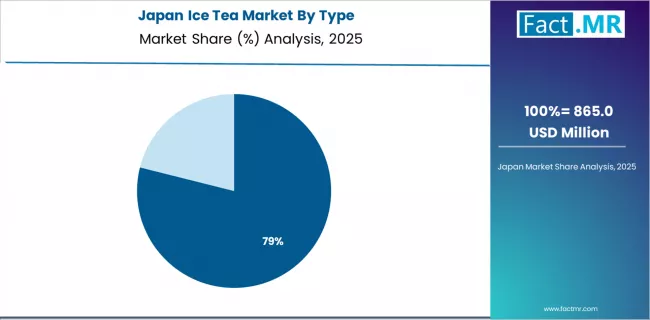
The ice tea market in Japan is expanding at a CAGR of 3.9%, supported by the country's established tea culture, quality beverage preferences, and strong emphasis on premium and authentic tea experiences supporting ice tea adoption for traditional and modern consumption occasions.
Japan's tea expertise and quality consciousness are driving demand for superior ice tea products. Leading tea companies are investing in specialized capabilities for premium beverage applications and traditional tea culture integration.
- Advanced tea culture and quality beverage focus are creating opportunities for ice tea products throughout convenience stores, vending machines, and specialty tea retailers serving traditional tea consumers and modern beverage markets.
- Strong quality standards and tea culture appreciation are driving adoption of premium ice tea formulations meeting Japanese consumer expectations for authenticity, quality, and comprehensive tea experience across diverse consumption occasions.
Europe Market Split by Country
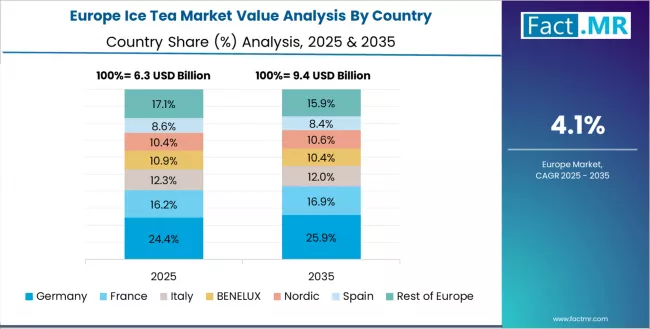
The ice tea market in Europe is projected to grow from USD 6.8 billion in 2025 to USD 10.2 billion by 2035, reflecting a CAGR of 4.2% over the forecast period. Germany is expected to retain its leading position with a 29.4% market share in 2025, slightly moderating to 29.2% by 2035. Growth in Germany is supported by strong consumer preference for natural and organic beverages, rising health consciousness, and a focus on quality-driven consumption patterns.
France follows with a 23.5% share in 2025, anticipated to reach 23.7% by 2035, driven by a well-established premium beverage culture, growing health awareness, and an increasing appreciation for sophisticated and flavorful tea experiences. The United Kingdom accounts for 21.3% of the market in 2025, projected to reach 21.4% by 2035, underpinned by the integration of tea culture into everyday consumption, rising demand for health-conscious beverages, and a preference for convenient, ready-to-drink formats.
Italy holds 13.2% of the European ice tea market in 2025, increasing slightly to 13.3% by 2035, supported by urbanization, growing RTD adoption, and consumer interest in functional and flavored beverages. Spain represents 8.8% in 2025, rising to 8.9% by 2035, with growth driven by expanding retail availability and increasing consumer inclination toward natural and refreshing drinks.
The rest of Europe region is projected to account for 3.8% in 2025, decreasing slightly to 3.5% by 2035, reflecting steady adoption of health-oriented beverages in Nordic countries and emerging growth opportunities in Eastern European markets.
Competitive Landscape of the Ice Tea Market

The ice tea market is characterized by competition among established beverage giants, specialized tea companies, and regional beverage manufacturers. Companies are investing in flavor innovation development, health-focused formulation research, production efficiency enhancement, and distribution network expansion to deliver refreshing, healthy, and accessible ice tea solutions. Innovation in sugar reduction, functional ingredient integration, and premium flavor development is central to strengthening market position and competitive advantage.
Coca-Cola leads the market with a 10.5% share through its Fuze and Gold Peak brands, offering comprehensive ice tea solutions with focus on flavor innovation, health-conscious formulations, and extensive global distribution serving diverse consumer preferences and market segments. The company continues investing in research and development while expanding product portfolio and retail partnerships.
PepsiCo Lipton provides strong market presence with emphasis on mainstream accessibility and flavor variety. Nestlé offers premium positioning with quality focus and international reach. Arizona Beverage specializes in distinctive packaging and bold flavors. Ito En emphasizes authentic Japanese tea expertise and premium quality. Keurig Dr Pepper focuses on regional strength and diverse portfolio management.
Key Players in the Ice Tea Market
- The Coca-Cola Company (Fuze Tea & Gold Peak Brands)
- PepsiCo, Inc. (Lipton Iced Tea, in partnership with Unilever)
- Nestlé S.A.
- Arizona Beverage Company LLC
- Ito En, Ltd.
- Keurig Dr Pepper Inc.
- Asahi Group Holdings, Ltd.
- Suntory Holdings Limited
- Unilever PLC
- Nongfu Spring Co., Ltd.
Scope of the Report
| Items | Values |
|---|---|
| Quantitative Units (2025) | USD 25.0 Billion |
| Type | Ready-to-drink, Powder/Instant |
| Sweetener | Reduced/No Sugar, Standard Sugar |
| Distribution Channel | Retail, Foodservice, Online |
| Regions Covered | North America, Asia-Pacific, Europe, Latin America, Middle East & Africa |
| Countries Covered | USA, Mexico, Germany, France, UK, Japan, South Korea, and 40+ countries |
| Key Companies Profiled | Coca-Cola, PepsiCo Lipton, Nestlé, Arizona Beverage, Ito En, Keurig Dr Pepper |
| Additional Attributes | Dollar sales by type and sweetener, regional demand trends, competitive landscape, technological advancements in beverage processing, health-focused formulation development, flavor innovation enhancement, and sustainable packaging solutions |
Ice Tea Market by Segments
-
Type :
- Ready-to-drink
- Powder/Instant
-
Sweetener :
- Reduced/No Sugar
- Standard Sugar
-
Distribution Channel :
- Retail
- Foodservice
- Online
-
Region :
- North America
- United States
- Canada
- Mexico
- Asia-Pacific
- Japan
- South Korea
- China
- India
- Australia
- Rest of Asia-Pacific
- Europe
- Germany
- United Kingdom
- France
- Italy
- Spain
- Netherlands
- Rest of Europe
- Latin America
- Brazil
- Argentina
- Rest of Latin America
- Middle East & Africa
- Kingdom of Saudi Arabia
- South Africa
- Rest of Middle East & Africa
- North America
Table of Content
- Executive Summary
- Global Market Outlook
- Demand to side Trends
- Supply to side Trends
- Technology Roadmap Analysis
- Analysis and Recommendations
- Market Overview
- Market Coverage / Taxonomy
- Market Definition / Scope / Limitations
- Market Background
- Market Dynamics
- Drivers
- Restraints
- Opportunity
- Trends
- Scenario Forecast
- Demand in Optimistic Scenario
- Demand in Likely Scenario
- Demand in Conservative Scenario
- Opportunity Map Analysis
- Product Life Cycle Analysis
- Supply Chain Analysis
- Investment Feasibility Matrix
- Value Chain Analysis
- PESTLE and Porter’s Analysis
- Regulatory Landscape
- Regional Parent Market Outlook
- Production and Consumption Statistics
- Import and Export Statistics
- Market Dynamics
- Global Market Analysis 2020 to 2024 and Forecast, 2025 to 2035
- Historical Market Size Value (USD Million) Analysis, 2020 to 2024
- Current and Future Market Size Value (USD Million) Projections, 2025 to 2035
- Y to o to Y Growth Trend Analysis
- Absolute $ Opportunity Analysis
- Global Market Pricing Analysis 2020 to 2024 and Forecast 2025 to 2035
- Global Market Analysis 2020 to 2024 and Forecast 2025 to 2035, By Type
- Introduction / Key Findings
- Historical Market Size Value (USD Million) Analysis By Type , 2020 to 2024
- Current and Future Market Size Value (USD Million) Analysis and Forecast By Type , 2025 to 2035
- Ready-to-drink
- Powder/Instant
- Y to o to Y Growth Trend Analysis By Type , 2020 to 2024
- Absolute $ Opportunity Analysis By Type , 2025 to 2035
- Global Market Analysis 2020 to 2024 and Forecast 2025 to 2035, By Sweetener
- Introduction / Key Findings
- Historical Market Size Value (USD Million) Analysis By Sweetener, 2020 to 2024
- Current and Future Market Size Value (USD Million) Analysis and Forecast By Sweetener, 2025 to 2035
- Reduced/No Sugar
- Standard Sugar
- Y to o to Y Growth Trend Analysis By Sweetener, 2020 to 2024
- Absolute $ Opportunity Analysis By Sweetener, 2025 to 2035
- Global Market Analysis 2020 to 2024 and Forecast 2025 to 2035, By Region
- Introduction
- Historical Market Size Value (USD Million) Analysis By Region, 2020 to 2024
- Current Market Size Value (USD Million) Analysis and Forecast By Region, 2025 to 2035
- North America
- Latin America
- Western Europe
- Eastern Europe
- East Asia
- South Asia and Pacific
- Middle East & Africa
- Market Attractiveness Analysis By Region
- North America Market Analysis 2020 to 2024 and Forecast 2025 to 2035, By Country
- Historical Market Size Value (USD Million) Trend Analysis By Market Taxonomy, 2020 to 2024
- Market Size Value (USD Million) Forecast By Market Taxonomy, 2025 to 2035
- By Country
- USA
- Canada
- Mexico
- By Type
- By Sweetener
- By Country
- Market Attractiveness Analysis
- By Country
- By Type
- By Sweetener
- Key Takeaways
- Latin America Market Analysis 2020 to 2024 and Forecast 2025 to 2035, By Country
- Historical Market Size Value (USD Million) Trend Analysis By Market Taxonomy, 2020 to 2024
- Market Size Value (USD Million) Forecast By Market Taxonomy, 2025 to 2035
- By Country
- Brazil
- Chile
- Rest of Latin America
- By Type
- By Sweetener
- By Country
- Market Attractiveness Analysis
- By Country
- By Type
- By Sweetener
- Key Takeaways
- Western Europe Market Analysis 2020 to 2024 and Forecast 2025 to 2035, By Country
- Historical Market Size Value (USD Million) Trend Analysis By Market Taxonomy, 2020 to 2024
- Market Size Value (USD Million) Forecast By Market Taxonomy, 2025 to 2035
- By Country
- Germany
- UK
- Italy
- Spain
- France
- Nordic
- BENELUX
- Rest of Western Europe
- By Type
- By Sweetener
- By Country
- Market Attractiveness Analysis
- By Country
- By Type
- By Sweetener
- Key Takeaways
- Eastern Europe Market Analysis 2020 to 2024 and Forecast 2025 to 2035, By Country
- Historical Market Size Value (USD Million) Trend Analysis By Market Taxonomy, 2020 to 2024
- Market Size Value (USD Million) Forecast By Market Taxonomy, 2025 to 2035
- By Country
- Russia
- Poland
- Hungary
- Balkan & Baltic
- Rest of Eastern Europe
- By Type
- By Sweetener
- By Country
- Market Attractiveness Analysis
- By Country
- By Type
- By Sweetener
- Key Takeaways
- East Asia Market Analysis 2020 to 2024 and Forecast 2025 to 2035, By Country
- Historical Market Size Value (USD Million) Trend Analysis By Market Taxonomy, 2020 to 2024
- Market Size Value (USD Million) Forecast By Market Taxonomy, 2025 to 2035
- By Country
- China
- Japan
- South Korea
- By Type
- By Sweetener
- By Country
- Market Attractiveness Analysis
- By Country
- By Type
- By Sweetener
- Key Takeaways
- South Asia and Pacific Market Analysis 2020 to 2024 and Forecast 2025 to 2035, By Country
- Historical Market Size Value (USD Million) Trend Analysis By Market Taxonomy, 2020 to 2024
- Market Size Value (USD Million) Forecast By Market Taxonomy, 2025 to 2035
- By Country
- India
- ASEAN
- Australia & New Zealand
- Rest of South Asia and Pacific
- By Type
- By Sweetener
- By Country
- Market Attractiveness Analysis
- By Country
- By Type
- By Sweetener
- Key Takeaways
- Middle East & Africa Market Analysis 2020 to 2024 and Forecast 2025 to 2035, By Country
- Historical Market Size Value (USD Million) Trend Analysis By Market Taxonomy, 2020 to 2024
- Market Size Value (USD Million) Forecast By Market Taxonomy, 2025 to 2035
- By Country
- Kingdom of Saudi Arabia
- Other GCC Countries
- Turkiye
- South Africa
- Other African Union
- Rest of Middle East & Africa
- By Type
- By Sweetener
- By Country
- Market Attractiveness Analysis
- By Country
- By Type
- By Sweetener
- Key Takeaways
- Key Countries Market Analysis
- USA
- Pricing Analysis
- Market Share Analysis, 2024
- By Type
- By Sweetener
- Canada
- Pricing Analysis
- Market Share Analysis, 2024
- By Type
- By Sweetener
- Mexico
- Pricing Analysis
- Market Share Analysis, 2024
- By Type
- By Sweetener
- Brazil
- Pricing Analysis
- Market Share Analysis, 2024
- By Type
- By Sweetener
- Chile
- Pricing Analysis
- Market Share Analysis, 2024
- By Type
- By Sweetener
- Germany
- Pricing Analysis
- Market Share Analysis, 2024
- By Type
- By Sweetener
- UK
- Pricing Analysis
- Market Share Analysis, 2024
- By Type
- By Sweetener
- Italy
- Pricing Analysis
- Market Share Analysis, 2024
- By Type
- By Sweetener
- Spain
- Pricing Analysis
- Market Share Analysis, 2024
- By Type
- By Sweetener
- France
- Pricing Analysis
- Market Share Analysis, 2024
- By Type
- By Sweetener
- India
- Pricing Analysis
- Market Share Analysis, 2024
- By Type
- By Sweetener
- ASEAN
- Pricing Analysis
- Market Share Analysis, 2024
- By Type
- By Sweetener
- Australia & New Zealand
- Pricing Analysis
- Market Share Analysis, 2024
- By Type
- By Sweetener
- China
- Pricing Analysis
- Market Share Analysis, 2024
- By Type
- By Sweetener
- Japan
- Pricing Analysis
- Market Share Analysis, 2024
- By Type
- By Sweetener
- South Korea
- Pricing Analysis
- Market Share Analysis, 2024
- By Type
- By Sweetener
- Russia
- Pricing Analysis
- Market Share Analysis, 2024
- By Type
- By Sweetener
- Poland
- Pricing Analysis
- Market Share Analysis, 2024
- By Type
- By Sweetener
- Hungary
- Pricing Analysis
- Market Share Analysis, 2024
- By Type
- By Sweetener
- Kingdom of Saudi Arabia
- Pricing Analysis
- Market Share Analysis, 2024
- By Type
- By Sweetener
- Turkiye
- Pricing Analysis
- Market Share Analysis, 2024
- By Type
- By Sweetener
- South Africa
- Pricing Analysis
- Market Share Analysis, 2024
- By Type
- By Sweetener
- USA
- Market Structure Analysis
- Competition Dashboard
- Competition Benchmarking
- Market Share Analysis of Top Players
- By Regional
- By Type
- By Sweetener
- Competition Analysis
- Competition Deep Dive
- The Coca-Cola Company (Fuze Tea & Gold Peak Brands)
- Overview
- Product Portfolio
- Profitability by Market Segments (Product/Age /Sales Channel/Region)
- Sales Footprint
- Strategy Overview
- Marketing Strategy
- Product Strategy
- Channel Strategy
- PepsiCo, Inc. (Lipton Iced Tea, in partnership with Unilever)
- Nestlé S.A.
- Arizona Beverage Company LLC
- Ito En, Ltd.
- Keurig Dr Pepper Inc.
- Asahi Group Holdings, Ltd.
- Suntory Holdings Limited
- Unilever PLC
- Nongfu Spring Co., Ltd.
- The Coca-Cola Company (Fuze Tea & Gold Peak Brands)
- Competition Deep Dive
- Assumptions & Acronyms Used
- Research Methodology
List Of Table
- Table 1: Global Market Value (USD Million) Forecast by Region, 2020 to 2035
- Table 2: Global Market Value (USD Million) Forecast by Type , 2020 to 2035
- Table 3: Global Market Value (USD Million) Forecast by Sweetener, 2020 to 2035
- Table 4: North America Market Value (USD Million) Forecast by Country, 2020 to 2035
- Table 5: North America Market Value (USD Million) Forecast by Type , 2020 to 2035
- Table 6: North America Market Value (USD Million) Forecast by Sweetener, 2020 to 2035
- Table 7: Latin America Market Value (USD Million) Forecast by Country, 2020 to 2035
- Table 8: Latin America Market Value (USD Million) Forecast by Type , 2020 to 2035
- Table 9: Latin America Market Value (USD Million) Forecast by Sweetener, 2020 to 2035
- Table 10: Western Europe Market Value (USD Million) Forecast by Country, 2020 to 2035
- Table 11: Western Europe Market Value (USD Million) Forecast by Type , 2020 to 2035
- Table 12: Western Europe Market Value (USD Million) Forecast by Sweetener, 2020 to 2035
- Table 13: Eastern Europe Market Value (USD Million) Forecast by Country, 2020 to 2035
- Table 14: Eastern Europe Market Value (USD Million) Forecast by Type , 2020 to 2035
- Table 15: Eastern Europe Market Value (USD Million) Forecast by Sweetener, 2020 to 2035
- Table 16: East Asia Market Value (USD Million) Forecast by Country, 2020 to 2035
- Table 17: East Asia Market Value (USD Million) Forecast by Type , 2020 to 2035
- Table 18: East Asia Market Value (USD Million) Forecast by Sweetener, 2020 to 2035
- Table 19: South Asia and Pacific Market Value (USD Million) Forecast by Country, 2020 to 2035
- Table 20: South Asia and Pacific Market Value (USD Million) Forecast by Type , 2020 to 2035
- Table 21: South Asia and Pacific Market Value (USD Million) Forecast by Sweetener, 2020 to 2035
- Table 22: Middle East & Africa Market Value (USD Million) Forecast by Country, 2020 to 2035
- Table 23: Middle East & Africa Market Value (USD Million) Forecast by Type , 2020 to 2035
- Table 24: Middle East & Africa Market Value (USD Million) Forecast by Sweetener, 2020 to 2035
List Of Figures
- Figure 1: Global Market Pricing Analysis
- Figure 2: Global Market Value (USD Million) Forecast 2020-2035
- Figure 3: Global Market Value Share and BPS Analysis by Type , 2025 and 2035
- Figure 4: Global Market Y to o to Y Growth Comparison by Type , 2025-2035
- Figure 5: Global Market Attractiveness Analysis by Type
- Figure 6: Global Market Value Share and BPS Analysis by Sweetener, 2025 and 2035
- Figure 7: Global Market Y to o to Y Growth Comparison by Sweetener, 2025-2035
- Figure 8: Global Market Attractiveness Analysis by Sweetener
- Figure 9: Global Market Value (USD Million) Share and BPS Analysis by Region, 2025 and 2035
- Figure 10: Global Market Y to o to Y Growth Comparison by Region, 2025-2035
- Figure 11: Global Market Attractiveness Analysis by Region
- Figure 12: North America Market Incremental Dollar Opportunity, 2025-2035
- Figure 13: Latin America Market Incremental Dollar Opportunity, 2025-2035
- Figure 14: Western Europe Market Incremental Dollar Opportunity, 2025-2035
- Figure 15: Eastern Europe Market Incremental Dollar Opportunity, 2025-2035
- Figure 16: East Asia Market Incremental Dollar Opportunity, 2025-2035
- Figure 17: South Asia and Pacific Market Incremental Dollar Opportunity, 2025-2035
- Figure 18: Middle East & Africa Market Incremental Dollar Opportunity, 2025-2035
- Figure 19: North America Market Value Share and BPS Analysis by Country, 2025 and 2035
- Figure 20: North America Market Value Share and BPS Analysis by Type , 2025 and 2035
- Figure 21: North America Market Y to o to Y Growth Comparison by Type , 2025-2035
- Figure 22: North America Market Attractiveness Analysis by Type
- Figure 23: North America Market Value Share and BPS Analysis by Sweetener, 2025 and 2035
- Figure 24: North America Market Y to o to Y Growth Comparison by Sweetener, 2025-2035
- Figure 25: North America Market Attractiveness Analysis by Sweetener
- Figure 26: Latin America Market Value Share and BPS Analysis by Country, 2025 and 2035
- Figure 27: Latin America Market Value Share and BPS Analysis by Type , 2025 and 2035
- Figure 28: Latin America Market Y to o to Y Growth Comparison by Type , 2025-2035
- Figure 29: Latin America Market Attractiveness Analysis by Type
- Figure 30: Latin America Market Value Share and BPS Analysis by Sweetener, 2025 and 2035
- Figure 31: Latin America Market Y to o to Y Growth Comparison by Sweetener, 2025-2035
- Figure 32: Latin America Market Attractiveness Analysis by Sweetener
- Figure 33: Western Europe Market Value Share and BPS Analysis by Country, 2025 and 2035
- Figure 34: Western Europe Market Value Share and BPS Analysis by Type , 2025 and 2035
- Figure 35: Western Europe Market Y to o to Y Growth Comparison by Type , 2025-2035
- Figure 36: Western Europe Market Attractiveness Analysis by Type
- Figure 37: Western Europe Market Value Share and BPS Analysis by Sweetener, 2025 and 2035
- Figure 38: Western Europe Market Y to o to Y Growth Comparison by Sweetener, 2025-2035
- Figure 39: Western Europe Market Attractiveness Analysis by Sweetener
- Figure 40: Eastern Europe Market Value Share and BPS Analysis by Country, 2025 and 2035
- Figure 41: Eastern Europe Market Value Share and BPS Analysis by Type , 2025 and 2035
- Figure 42: Eastern Europe Market Y to o to Y Growth Comparison by Type , 2025-2035
- Figure 43: Eastern Europe Market Attractiveness Analysis by Type
- Figure 44: Eastern Europe Market Value Share and BPS Analysis by Sweetener, 2025 and 2035
- Figure 45: Eastern Europe Market Y to o to Y Growth Comparison by Sweetener, 2025-2035
- Figure 46: Eastern Europe Market Attractiveness Analysis by Sweetener
- Figure 47: East Asia Market Value Share and BPS Analysis by Country, 2025 and 2035
- Figure 48: East Asia Market Value Share and BPS Analysis by Type , 2025 and 2035
- Figure 49: East Asia Market Y to o to Y Growth Comparison by Type , 2025-2035
- Figure 50: East Asia Market Attractiveness Analysis by Type
- Figure 51: East Asia Market Value Share and BPS Analysis by Sweetener, 2025 and 2035
- Figure 52: East Asia Market Y to o to Y Growth Comparison by Sweetener, 2025-2035
- Figure 53: East Asia Market Attractiveness Analysis by Sweetener
- Figure 54: South Asia and Pacific Market Value Share and BPS Analysis by Country, 2025 and 2035
- Figure 55: South Asia and Pacific Market Value Share and BPS Analysis by Type , 2025 and 2035
- Figure 56: South Asia and Pacific Market Y to o to Y Growth Comparison by Type , 2025-2035
- Figure 57: South Asia and Pacific Market Attractiveness Analysis by Type
- Figure 58: South Asia and Pacific Market Value Share and BPS Analysis by Sweetener, 2025 and 2035
- Figure 59: South Asia and Pacific Market Y to o to Y Growth Comparison by Sweetener, 2025-2035
- Figure 60: South Asia and Pacific Market Attractiveness Analysis by Sweetener
- Figure 61: Middle East & Africa Market Value Share and BPS Analysis by Country, 2025 and 2035
- Figure 62: Middle East & Africa Market Value Share and BPS Analysis by Type , 2025 and 2035
- Figure 63: Middle East & Africa Market Y to o to Y Growth Comparison by Type , 2025-2035
- Figure 64: Middle East & Africa Market Attractiveness Analysis by Type
- Figure 65: Middle East & Africa Market Value Share and BPS Analysis by Sweetener, 2025 and 2035
- Figure 66: Middle East & Africa Market Y to o to Y Growth Comparison by Sweetener, 2025-2035
- Figure 67: Middle East & Africa Market Attractiveness Analysis by Sweetener
- Figure 68: Global Market - Tier Structure Analysis
- Figure 69: Global Market - Company Share Analysis
- FAQs -
How big is the ice tea market in 2025?
The global ice tea market is estimated to be valued at USD 25.0 billion in 2025.
What will be the size of ice tea market in 2035?
The market size for the ice tea market is projected to reach USD 39.5 billion by 2035.
How much will be the ice tea market growth between 2025 and 2035?
The ice tea market is expected to grow at a 4.7% CAGR between 2025 and 2035.
What are the key product types in the ice tea market?
The key product types in ice tea market are ready-to-drink and powder/instant.
Which sweetener segment to contribute significant share in the ice tea market in 2025?
In terms of sweetener, reduced/no sugar segment to command 52.0% share in the ice tea market in 2025.